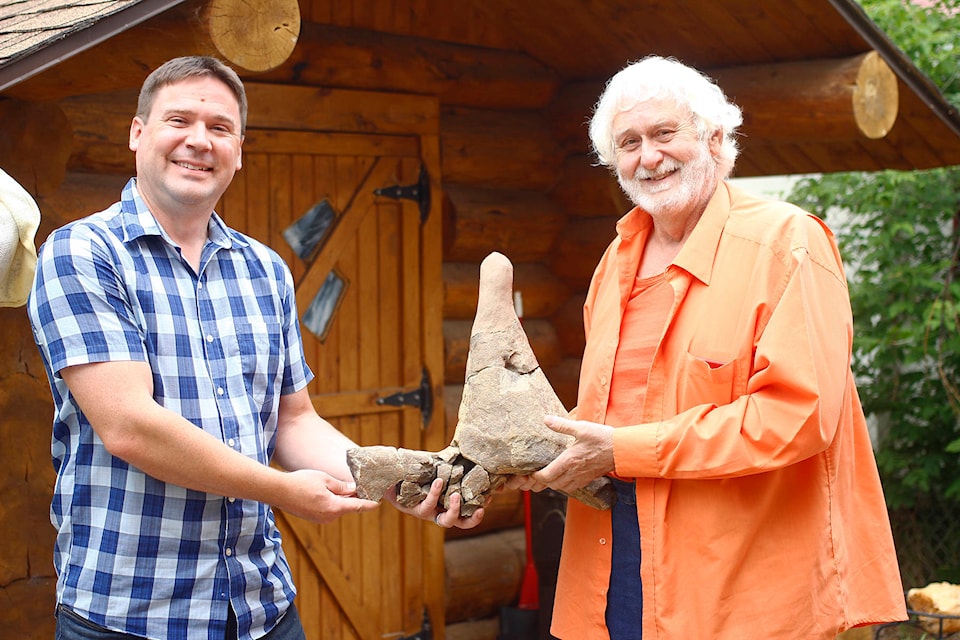The McCue family in Ponoka recently donated an artifact to the Royal Tyrrell Museum in Drumheller, and museum experts say it is a significant specimen.
Garry McCue hunted for dinosaur fossils for nearly 60 years across the province.
“Friends and I, when we were young, decided we didn’t like the idea of hunting,” said McCue.
“We decided we were just looking for an excuse when we went hunting to be with the boys, out in the countryside. We found some fossils and we decided, ‘Why don’t we start looking for dinosaurs?’” he said.
“We found a lot.”
Later, he would continue the tradition and hunt for dinosaur bones with his children.
Now, decades later, the family has quite the collection and it’s time to find new homes for some of their pieces.
“As we’re 75, it’s time to move things on … we’re re-homing things,” said McCue.
One of the first items to be rehomed turned out to be a significant find when it comes to understanding which species of Triceratops lived in Alberta.
The specimen was found somewhere along the Red Deer River Valley north of Drumheller.
Dr. Caleb Brown, palaeontologist and curator of dinosaur systematics and evolution at the Tyrrell, came to Ponoka to see the piece this summer.
The fossil is part of the nasal bone, including part of the horn, of a Triceratops, according to Dr. Brown.
“Given the shape of the horn, the specimen is identifiable to species level: Triceratops prorsus,” he said.
Brown says Triceratops is well-known from late Cretaceous deposits in the United States but are less common in Alberta.
There are currently two species of Triceratops recognized in the American Hell Creek Formation: Triceratops horridus and Triceratops prorsus.
“Several Triceratops specimens have been found along the Red Deer River Valley over the last 80 years, but they are all incomplete and lack the diagnostic parts needed to determine which species is present here,” said Brown.
“While this specimen is only a very small chunk of the entire skull, it is important because it shows some of the diagnostic features that allow us to determine which of the two species of Triceratops occurs in the Red Deer River Valley.”
Identifying the species of Triceratops allows for fine-scale comparisons between the dinosaurs that lived in Alberta and helps to put Alberta’s dinosaur fossil record at the very end of the Cretaceous in context with the record from the western States, he says.
Fossils found since 1978 are protected under the Historical Recourses Act and are owned by the province. This piece was found by the McCues before the act came into effect.
“Garry and his family have generously decided to donate the specimen to the Royal Tyrrell Museum of Palaeontology in Drumheller, Alberta,” said Brown.
“Given its scientific importance, this will allow the specimen to be researched, and may even end up on display. The great result of the story is that dinosaur bones collected a long time ago can still provide new information.”
While Brown was there to see the piece, the McCues were treated to an evaluation of some of their collection. It was the first time the items had been assessed.
Some of the pieces were determined to be Hadrosaur bone — one of the most commonly found dinosaur fossils found in Alberta — while others turned out to be pseudo-fossils, (iron stone or other materials that have taken the shape of a fossil).
What was shown was only an estimated four per cent of their entire collection.
“These are pieces that I thought Caleb should see,” said McCue.
When it comes to identifying fossils, a variety of clues are used such as the shape of the bone and any obvious diagnostic features.
“Things like size, texture and internal structure can also really help narrow down which type of bone or animal it is,” said Brown.
“Some other things like colour and surface markings can also give clues as to where the fossil came from and how long it has been exposed at the surface.”
